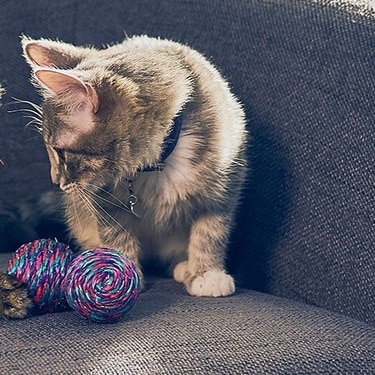
-
Hitta rätt mat för ditt husdjurGör det här testet för att se vilket foder som kan vara bäst för din pälskling.Hitta rätt mat för ditt husdjurGör det här testet för att se vilket foder som kan vara bäst för din pälskling.Utvalda produkter
 Hypoallergenic Adult Hundfoder
Hypoallergenic Adult HundfoderHill's Science Plan Hypoallergenic Adult våtfoder med lax är ett komplett helfoder av högsta kvalitet för alla vuxna hundar från 1 år och uppåt. Detta läckra våtfoder i burk är speciellt sammansatt för hundar med känslig hud och mage. Den innehåller en enda animalisk proteinkälla och är spannmålsfri.
Handla nu Hypoallergeniskt hundfoder för vuxna hundar med lax
Hypoallergeniskt hundfoder för vuxna hundar med laxHILL'S SCIENCE PLAN Hypoallergenic Large Breed Adult hundfoder med lax är ett komplett foder för vuxna hundar av stora raser i åldern 1–5 år. Det är särskilt framtaget för hundar med känslig hud och mage, med begränsade mängder högkvalitativa och nya proteinkällor samt utan spannmål.
Handla nu Healthy Mobility Medium Adult Hundfoder
Healthy Mobility Medium Adult HundfoderHill's Science Plan Healthy Mobility Medium Breed Adult Hundfoder med kyckling erbjuder en avancerad nutrition för att stödja ledhälsa och förbättra rörligheten. provides advanced nutrition to support joint health and improve mobility.
Handla nuHälsotillståndUtvalda produkter Sterilised Kattungefoder
Sterilised KattungefoderHill's SCIENCE PLAN Sterilised Kitten kattungefoder är skapat med Hill´s unika förståelse för de specifika behov som kastrerade kattungar har. Det bidrar med hög proteinkvalitet för muskelutveckling, med kontrollerat fett för att förebygga risk för övervikt efter kastrering. Dessutom har det en unik blandning av antioxidanter för att främja ett hälsosamt immunsystem för att stöjda din kattunges tillväxt.
Handla nu Hill's Science Plan Mature Adult Kattfoder Tonfisk
Hill's Science Plan Mature Adult Kattfoder TonfiskHill's Science Plan Adult kattfoder med lax är ett helfoder för äldre katter, speciellt utformat med ActivBiome+ Multi-Benefit teknologi.
Detta foder främjar ett värdigt åldrande hos katter och innehåller en synergistisk blandning av ingredienser som bidrar till att upprätthålla energi- och aktivitetsnivån.Handla nu Hill's Science Plan SENIOR VITALITY KATTFODER Kyckling, med laxHandla nu
Hill's Science Plan SENIOR VITALITY KATTFODER Kyckling, med laxHandla nu -
Till hundägare
- Tips och artiklar
-
Hälsokategori
- Vikthantering
- Miljö- och foderöverkänslighet
- Urinvägar
- Matsmältning
- Leder
- Njurar
-
Hundens livsstadium
- Näring för valpar
- Näring för vuxna katter
- Näring för seniorer
Till kattägare- Tips och artiklar
-
Hälsokategori
- Vikthantering
- Hud- & foderöverkänslighet
- Urinvägar
- Matsmältning
- Njurar
-
Kattens livsstadium
- Näring för kattungar
- Näring för vuxna
- Näring för seniorer
Utvalda artiklar Virtual Vet Visits: What You Need to Know
Virtual Vet Visits: What You Need to KnowLearn the ins and outs of a televet appointment before you talk to a vet online.
Läs mer Viktförändringar hos hundar och katter - kan det vara ett sköldkörtelproblem?
Viktförändringar hos hundar och katter - kan det vara ett sköldkörtelproblem?En viktförändring kan tyda på ett problem med sköldkörteln. Läs mer om tecken, orsaker och vad du kan göra åt det.
Läs mer Kristaller och stenar i hund- och katturin
Kristaller och stenar i hund- och katturinLäs om orsaker till och behandlingar av kristaller i hund- och katturin för att bibehålla hundens eller kattens hälsa. För expertråd om urinvård, besök Hill's Pet Sverige.
Läs mer -


When learning how to train your cat, you'll start with very basic first steps that both reward good behavior and discourage the bad. But can you train a cat the same way you might train a dog? Yes and no. Because they're highly independent animals, cats might appear aloof or uninterested in following your commands. That doesn't mean you can't influence their behavior, though. If you're patient and consistent, your new kitten or older cat can be trained in no time.
What Do You Want to Train?
First, determine what you'd like your cat to learn, then move toward them in small ways each day. Before you start training your cat, however, consider what commands you'll use and what types of behavioral actions you want her to learn. Think about what you may have wondered in the past: how to train your cat to use a litter box, how to keep her calm on trips to the veterinarian's office, and the like. How can you teach her stop scratching your rugs or furniture? These are all options you can work on during training.
Some common objectives include:
- House training or litter training.
- Coming to you when you call or gesture.
- Staying calm and still for grooming.
- Interacting with you, other people, or other animals.
- Playing with toys, with you, or with another cat.
- Calm traveling (getting into carrier and riding in the car).
There are many important reasons to learn why and how to train your cat. But above all, teaching her to behave in certain ways will help her become social and content around humans and other animals. Training is also important for your own well-being; if your cat learns to be calm during nail-trimming or travel, there will be no anxiety for her or you. The better mannered your cat is, the better your relationship will be.
Keep Each 'Session' Short and Natural
Having determined which lessons you and your cat will master, it's time to get down to business. First and foremost, your cat's attention span is shorter than yours; you can't expect her to stay interested every time you're ready to be the trainer. Let the lesson dictate how long she's willing to be in your company.
Because some kittens take to potty training quickly (or even before coming home with you) after watching their mother use a litter box, this type of training time may be brief. However, you may still need to lead her back to the little box in the early stages to remind her where it is. If you're training your kitten to play with her toys (and you), however, the lessons might be more gradual. Cats often prefer to explore new toys on their own, which means your role should be to respect her space while remaining approachable during her exploration. Then once she's acquainted herself with a new item, you can participate.
Start Small
If you're excited about training, you may want to jump right in and teach your cat everything at once. To be successful, though, it's a better idea to practice one lesson at a time. Once your cat has mastered whatever you're working on, you can move on to the next training exercise. When bringing a new kitten home, for example, you may want to litter train her right away. Once you're done you can work on interacting with other pets, then calm grooming, and so on.


Smakrika tips
Kattungar kan behöva flera besök under sitt första år för vaccinationer. Vuxna katter har i allmänhet nytta av årliga kontroller, medan seniorkatter eller katter med särskilda behov kan behöva mer frekventa besök.
Don't Limit Her to One Area
Once your cat has learned a command, practice it in different areas of your home. If you're introducing a kitten to other preexisting pets, and only bring them together in the living room, she may believe the other animal only exists in that space. This isn't a problem if your other animal is a fish, but if your kitten is meeting a dog, she needs to understand she'll encounter him in other areas as well.
Much like litter training, some types of training may require using different areas of your home. If you are house training a cat, it's sometimes necessary to have more than one litter box available. Keeping her from scratching carpet and furniture will also warrant a more comprehensive lesson, as she'll find these items in more than one room.
Involve Other People

If the only two residents are you and your cat, you don't have to worry too much about involving others in the training process. Yet you still want your cat to learn to be social, not territorial. Shortly after bringing your cat home, invite friends or family members over to socialize with your new pet. Just remind them not to be too forward with their introduction. Just as you practice training in small spurts, you should allow your pet the same leeway.
If you're bringing a kitten into a larger family, it's even more important to involve everyone in the training process. There are many reasons why the entire family should get involved, but it's most important for consistency and relationship-building. After all, she'll see these familiar faces every day! Everyone should be clear on the training goals and which methods you'll employ to be successful.
Use A Reward System
Rewards to reinforce good behavior are great motivators, especially during training. There are two types of rewards for your furry new friend to test out. First, know she will enjoy any positive praise you have to share. Speak in a kind, upbeat voice and remind her how proud you are. Say, "What a good girl" and "good job!" while petting or scratching her fur so she knows these gestures mean well.
Cats also respond well to treats. Reward her with small kibbles of Science Diet® cat food when she correctly masters the commands you're working on. One way to do this is to use a "clicker" system. When your cat preforms the right behavior or action, sound a tool that clicks, and then give her a treat that signals a job well done. Hearing this noise each time she does a job well done will reinforce the good behavior you're training her to learn.
If It Isn't Working
Training doesn't happen overnight, and sometimes your cat will make a mistake. Can you train a cat to bounce back from it? Of course, but before you begin, you should come up with a plan for how to correct or guide her when she seems reluctant to catch on. Punishment doesn't work well when you're trying to train a kitten because your cat simply won't understand why she's in trouble. In fact, it could make her worse and feel more reclusive.
You'd never slap, shake, or physically correct your kitten during training, but don't forget to keep your voice just as calm. If your cat feels threatened by you, not only will training begin to fail, but she'll only learn to be afraid of you.
If you do need to redirect bad behavior (like scratching furniture) try making a quick, sharp noise. It'll also help if you say the same phrase every time, such as "Bam!" "Whoa!" or "Yow!" The point is to make your cat alert, and distract her from the current action or behavior. Avoid words that you regularly use, like "no!" or "hey!" as your cat will get confused when she hears it in a different context.
Learning how to train your cat can be a fun experience for your entire family. Just remember to be patient and positive, and you'll both get there.


Erin Ollila tror på ordens kraft och hur ett budskap kan informera – och till och med förvandla – sin tilltänkta publik. Hennes författarskap kan hittas över hela internet och i tryckt form, och inkluderar intervjuer, spökskrivning, blogginlägg och kreativ facklitteratur. Erin är en nörd för SEO och allt som rör sociala medier. Hon tog examen från Fairfield University med en M.F.A. i kreativt skrivande. Kontakta henne på Twitter @ReinventingErin eller läs mer om henne på http://erinollila.com.
Relaterade produkter

Hill's Science Plan Perfect Digestion Foder till Kattungar med Kyckling & Fullkornsris ger näring åt din kattunges unika mikrobiom och hjälper dem att nå sin fulla potential.

Hill's Science Plan Adult kattfoder med lax är ett helfoder för äldre katter, speciellt utformat med ActivBiome+ Multi-Benefit teknologi.
Detta foder främjar ett värdigt åldrande hos katter och innehåller en synergistisk blandning av ingredienser som bidrar till att upprätthålla energi- och aktivitetsnivån.

Hill's SCIENCE PLAN Sterilised Kitten kattungefoder är skapat med Hill´s unika förståelse för de specifika behov som kastrerade kattungar har. Det bidrar med hög proteinkvalitet för muskelutveckling, med kontrollerat fett för att förebygga risk för övervikt efter kastrering. Dessutom har det en unik blandning av antioxidanter för att främja ett hälsosamt immunsystem för att stöjda din kattunges tillväxt.

Relaterade artiklar

Läs den ultimata checklistan inför att du skaffar en ny kattunge så att du kan ge den, den bästa möjliga starten. För fler tips om skötsel av kattungar och råd om kattvård, besök Hill's Pet Sverige.

Lär dig mer om orsakerna till hårbollar hos katter och upptäck effektiva behandlingar för att hålla din katt frisk. Besök Hill's Pet Sverige för fler råd om katters hälsa.

Are you looking to get your cat more active? Does she constantly look bored? Then you may want to consider using a food-dispensing (also known as treat-dispensing) cat toy, which provides both physical and mental stimulation during snack times.

Upptäck roliga och engagerande spel för katter som även fungerar som bra motionskällor. Utforska spännande sätt att hålla din katt aktiv och underhållen!

Sätt din katt på diet utan att den märker det
Vår kalorifattiga sammansättning hjälper dig att kontrollera din katts vikt. Den innehåller högkvalitativt protein för att bygga slanka muskler och är tillverkad med noga utvalda ingredienser för en smakrik och näringsrik måltid. Kliniskt bevisade antioxidanter, vitamin C+E, bidrar till ett friskt immunförsvar.
Sätt din katt på diet utan att den märker det
Vår kalorifattiga sammansättning hjälper dig att kontrollera din katts vikt. Den innehåller högkvalitativt protein för att bygga slanka muskler och är tillverkad med noga utvalda ingredienser för en smakrik och näringsrik måltid. Kliniskt bevisade antioxidanter, vitamin C+E, bidrar till ett friskt immunförsvar.

